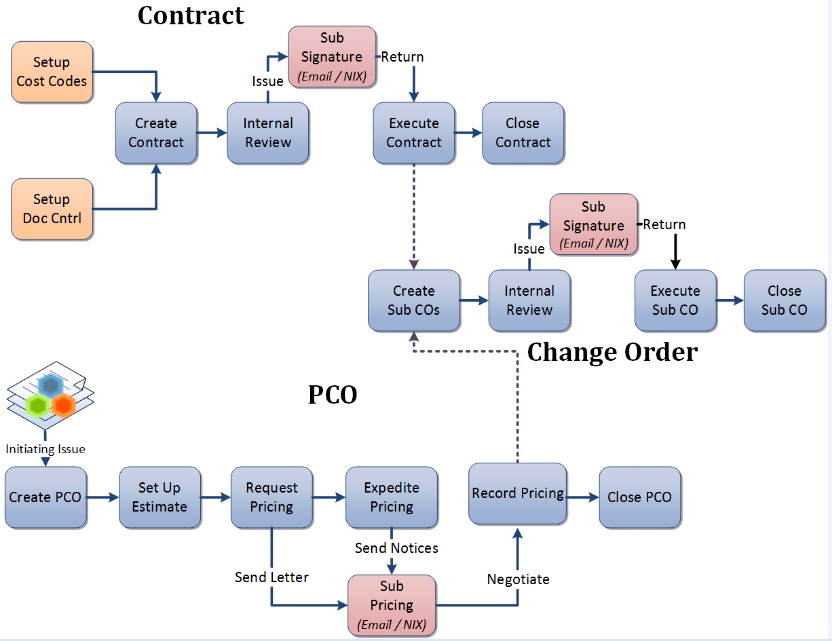Change Orders Overview
A change order (CO) is a signed written order legally amending a contract to affect a change in requirements, cost, or schedule to a previously negotiated contract. It incorporates changes previously negotiated by the owner and contractor through construction change directives and change order proposals. There are two types of COs: cost change orders and revenue change orders.
Cost COs
Cost COs affect downstream contracts where the from contractor is paying the to contractor. Cost contracts may be subcontracts, purchase orders, or professional services agreements.
Revenue COs
Revenue COs affect the upstream prime contract where the to contractor receives payment from the owner of the project. Some cost change orders may also be revenue change orders if the owner agrees to pay for the change.
Background
Depending on the terms of the prime contract, owner approval may be required on all cost change orders prior to giving any additional funds/time to subcontractors or suppliers. On other projects, the owner only reviews cost change orders that they will have to pay for through a revenue change order. A general contractor (GC) might have to issue a change order to a subcontractor (in order to keep project progress moving) prior to receiving official approval from the owner. In these cases, the GC is taking this action “at risk” and could end up having to absorb some or all of this cost change.
Pure cost change orders do not increase the total value of the project. Therefore, if the GC does not have contingency or an offsetting cost under-run, these change orders can reduce the GC’s profitability.
Change orders usually result in adding funds to a contract due to increased scope of work to the contractor. However, change orders can also have a negative value if work is removed from the contract due to cancellation or transfer to another party. Occasionally, change orders will have zero monetary value. This is the case if the terms and conditions are changed which alter the legal relationship between contract parties, or if revised contract documents (drawings, specifications, exhibits) are added to the contractor’s responsibility.
CO procedures are dictated by the contract. Some typical practices are:
● COs reference multiple construction change directives or change order proposals;
● COs may be written against subcontracts/purchase orders;
● To track contracts at a cost code level of detail, users must link potential change orders (PCOs) with the change order. A change order may include multiple pricing items from multiple PCOs.
● The party responsible for preparing the CO sends it out to be reviewed;
● The owner typically has final approval;
● Approved COs are distributed to the responsible parties.
Info Exchange support
COs can be logged and sent electronically via email or Info Exchange from Project Center. Within Info Exchange, external project team members can review COs that were forwarded to them for review, and reference COs that were sent in the log. Internal project team members can review and track COs using the full CO log in Info Exchange, enabling them to track the CO process via the web from any location.
Project Center users viewing the CO log in Info Exchange will see the full log and all the associated actions. Users logging into Info Exchange who are not Project Center users will only see the actions on which they are listed. These settings can be changed in the Groups and Info Exchange tab of the Modify Project Team Member dialog box.
Commitments workflow

Getting started
Use the Change Orders activity center to log and mange change orders (COs). You can use it to:
● Enter COs into the log either by:
● Creating the COs if you originate them;
● Logging a received CO if it was sent to you.
● Manage the CO log:
● Sort the log by due date, received date, total days, etc.;
● Quickly see which COs require attention;
● Create CO reports.
● Forward a CO to project team members or other contacts;
● Record feedback to COs;
● Track the final CO by linking to the file in the Supporting Documents tab;
● Generate the CO form conforming to your existing practice;
● Receive automatic reminders for CO reviews that are nearing their due date;
● Send CO information to team members at any time during the cycle;
● Associate email messages and supporting documents with a CO (similar to submittals);
● Sort and track COs by discipline and keywords.
The Contracts activity center must be available in the project for change orders to be enabled.
Quick reference guide
The following quick reference guide is available:
● Newforma Project Center Commitments Quick Reference Guide
Table of Contents
Index
Search (English only)
Back





